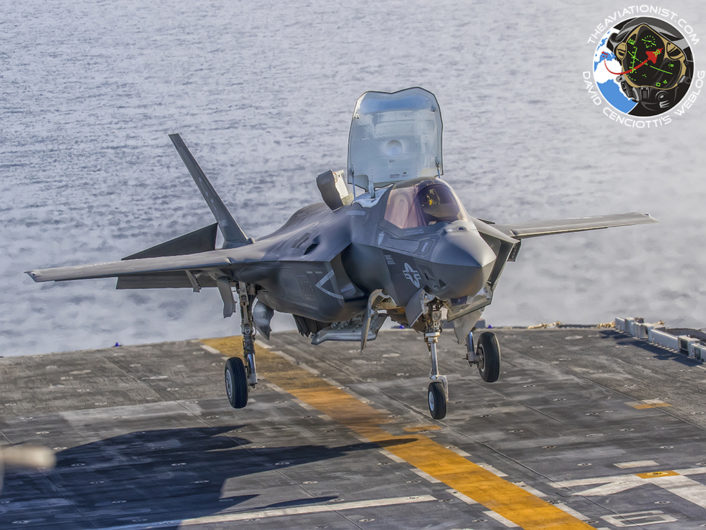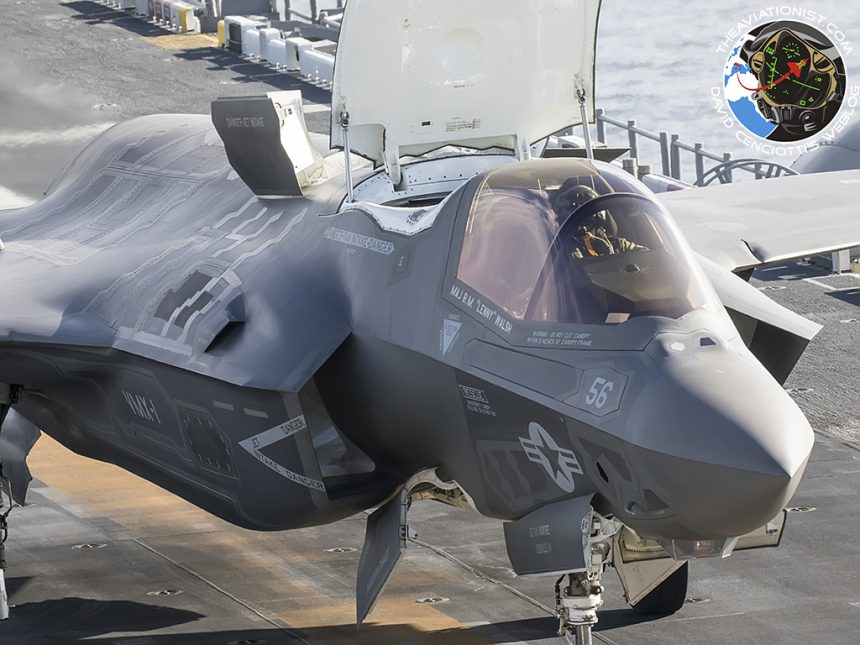The voice of the pilots is clear – the platform is working exceptionally. The F-35 is a platform with the ultimate level of sophistication, made simple. And therein lay the beauty of the F-35, and just why it will be so deadly, it’s simple.
The combined F-35 fleet now has over 75,000 flight hours, yet many continue to question the performance and value of the aircraft. Much of this can be expected given early program challenges, and the reality that many of the F-35s capabilities are classified. Add that many do not grasp the war the F-35 was designed to deter – or fight. 21st century warfare and capability has about as much in common with wars of the past as your 1970’s land line has to your smartphone. It is in this “smartphone” battlespace that the F-35 is designed to fight and to do so with a distinctly unfair advantage.
To understand the significance and value of the F-35, cut through the complexity and noise. Simplify. Put aside the politicians “it does not work!” the ideologues, the self-proclaimed experts and listen to the voice of the pilots. The pilots will take the aircraft into combat, their own lives in the balance as they penetrate contested space and are wildly outnumbered by adversary aircraft.
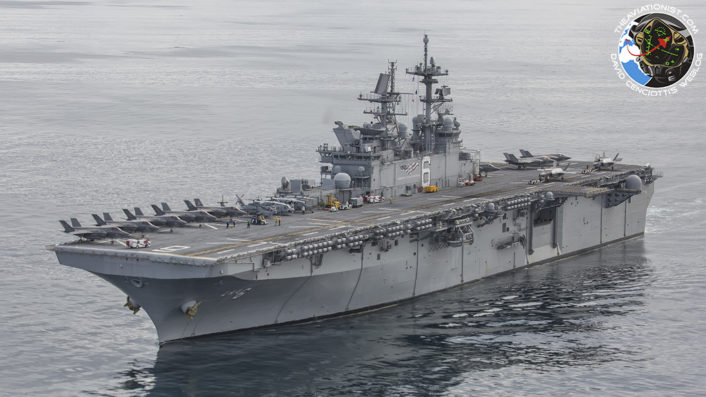
The Aviationist and a handful of journalists recently had the opportunity to visit with four such pilots during a “Proof of Concept” demonstration on the USS America, Nov. 19, 2016. The four pilots are some of the most experienced F-35B pilots in the United States Marine Corps (USMC) and their previous experience provides valuable context to their statements.
- George “Sack” Rowell, Commanding Officer (CO) of VMX-1 (Marine Operational Test & Evaluation Squadron). Prior to the F-35, Rowell spent appx. 3000 hours over 18 years of flying the F/A-18 Hornet. Previously the CO of VMFA(AW)-533
- Col. Chad “Mo” Vaughn, CO of VMFA-211. Prior to the F-35, Vaughn spent a couple 1000 hrs over 13 years in the F/A-18A-D Hornet, as well as time in the F-16A-B Fighting Falcon/Viper and F/A-18 Super Hornet at NAS Fallon.
- Col. Rich “BC” Rusnok, slated to become the CO of VMFA-121 in March 2017. Prior to the F-35, Price spent appx. 7 years flying the AV-8B Harrier II with additional time in the F/A-18 Hornet.
- Col. John “Guts” Price, slated CO for VFMA-122 (2018). Prior to the F-35, Price spent appx. 1200 hrs and 10 years flying the AV-8B Harrier II, and has about 400 hrs in the F-35 over the past 3 years.
The pilots provide unique insights, a different perspective on the F-35 and its unique capabilities. The comments have been edited for readability with best efforts made to maintain context and integrity of intent.
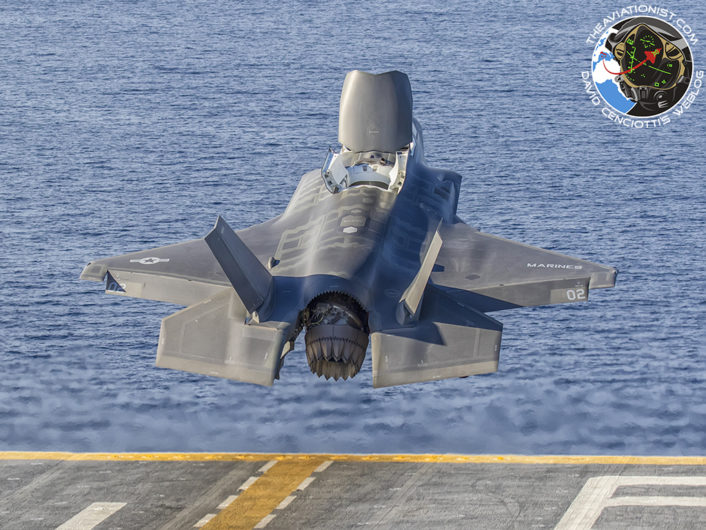
On a personal level as pilots, coming from other platforms and stepping into the F-35, do you have an “aha” moment that you can share?
Guts; My first “aha” moment was a seemingly simple thing. I was executing a familiarization flight near MCAS Yuma. I was coming back to the airfield and I basically just turned the jet and pointed its nose at Yuma. Immediately the jet is providing me the information of all the traffic that is out there in the airspace. When I talk to approach for the first time they are telling me about the traffic that is out there that I already know about and I see it. I can tell who everybody is that he is talking about and the jet also saw traffic that ATC hadn’t seen yet and I asked about it. And I thought, “Holy Cow!” here I am coming back to the field from a simple familiarity mission and my jet is telling me everything about the operational environment I am about to go into. In this case, something very simple, the traffic pattern coming back there, but I didn’t have to do anything to have that level of SA [Situational Awareness]. I can start making decisions about what altitude I wanted to go to, if I wanted to turn left or right, speed up or slow down. There’s somebody coming up next to me, I want to get in front of them – or whatever. It is a very simple example, but I thought WOW this is amazing that I see everything and can do that.
The other was the first time I vertically recovered the airplane. The flight control law that the airplane has is unbelievable and I always tell the anecdote. Flying AV-8B Harrier IIs, I only had one specific aircraft I felt like I could kind of go easy on the controls and it would sit there and hover. I love the Harrier, love flying that aircraft, but there was work involved to bring it back for a vertical landing. The very first time I hovered an F-35B I thought, I am the problem here, and I am just going to let the jet do what it wants to do. The F-35 was hovering better than I could ever hover a Harrier without doing a thing. That’s back to that workload comment I said earlier. I am performing a vertical landing, and I have the time to look around and see what is taking place on the pad and around me. It is a testament to the jet.
BC; I was conducting a strike mission and Red Air was coming at me. In a 4th Gen fighter you must do a whole lot of interpretation. You see things in azimuth, and you see things in elevation. In the F-35 you just see the God’s eye view of the whole world. It’s very much like you are watching the briefing in real time.
I am coming in to perform the simulated weapons release, and Red Air is coming the other direction. I have enough situational awareness to assess whether Red Air is going to be a factor to me by the time I release the weapon. I can make the decision, I’m going to go to the target, I’m going to release this weapon. Simultaneously I pre-target the threat, and as soon as I release the A2G weapon, I can flip a switch with my thumb and shoot the Red Air. This is difficult to do in a 4th Gen fighter, because there is so much manipulation of systems in the cockpit. All while paying attention to the basic mechanics of flying the airplane and interpreting threat warnings that are often very vague, or only directional. In the F-35 I know where the threats are, what they are and I can thread the needle. I can tell that the adversary is out in front of me and I can make a very, very smart decision about whether to continue or get out of there. All that, and I can very easily switch between mission sets.
Mo; I was leading a four ship of F-35s on a strike against 4th Gen adversaries, F-16s and F/A-18s. We fought our way in, we mapped the target, found the target, dropped JDAMs on the target and turned around and fought our way out. All the targets got hit, nobody got detected, and all the adversaries died. I thought, yes, this works, very, very, very well. Never detected, nobody had any idea we were out there.
A second moment was just this past Thursday. I spent a fair amount of my life as a tail hook guy – [landing F/A-18s on US Navy Supercarriers] on long carrier deployments. The last 18 seconds of a Carrier landing are intense. The last 18 seconds of making a vertical landing on this much smaller USMC Assault Carrier – is a lot more relaxed. The F-35C is doing some great stuff. Making a vertical landing [my first this week] on the moving ship, that is much smaller than anything I’ve landed on at sea – with less stress, was awesome.
Sack; It was my first flight at Edwards AFB Jan ’16. I got in the airplane and started it up. I was still on the deck and there were apparently other F-35s airborne – I believe USAF, I was not aware. I was a single ship, just supposed to go out and get familiar flying the aircraft. As the displays came alive there were track files and the SA as to what everyone else was doing in the airspace, and I was still on the ground. I mean, I hadn’t even gotten my take-off clearance yet. I didn’t even know where it was coming from. It was coming from another F-35. The jet had started all the systems for me and the SA was there. That was a very eye opening moment for me.
The second one, took place when I came back from that flight. In a Hornet you would pull into the line and had a very methodical way in which you have to shut off the airplane and the systems otherwise you could damage something. So you have to follow a sequence, it is very methodical about which electronic system you shut off. In the F-35 you come back, you do a couple things then you just shut the engine off, and it does everything else for you. Sounds simple, even silly – but it is a quantum shift.
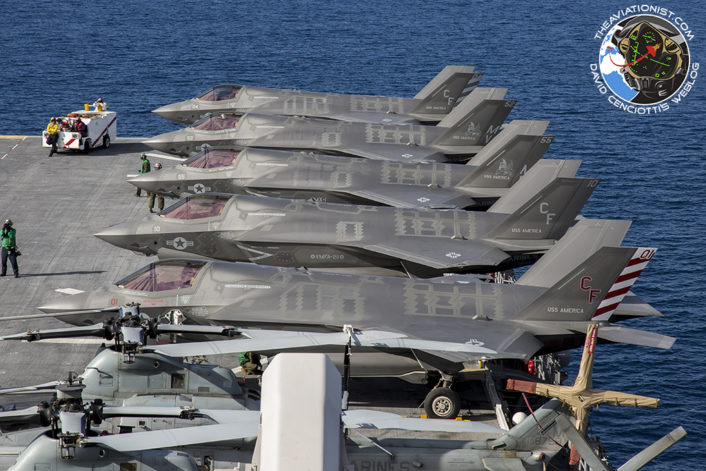
The voice of the pilots is clear – the platform is working exceptionally. The F-35 is a platform with the ultimate level of sophistication, made simple. And therein lay the beauty of the F-35, and just why it will be so deadly, it’s simple.
This article is but a small excerpt of the complete pilots discussion of our contributors full article found at The Second Line of Defense here.
The Aviationist thanks USMC pilots; Col. George “Sack” Rowell, Lt. Col. Chad “Mo” Vaughn, Lt. Col. Rich “BC” Rusnok, and Lt. Col. John “Guts” Price; Captain Joseph R. Olson, Commanding Officer of the USS America and entire crew; Sylvia Pierson, Brandi Schiff, JSF/JPO PA; Capt. Sarah Burns and 1st Lt. Maida Zheng, USMC PAOs; MV-22B pilots/crew and personnel of VMX-1.
